Duma about hetman Bogdan
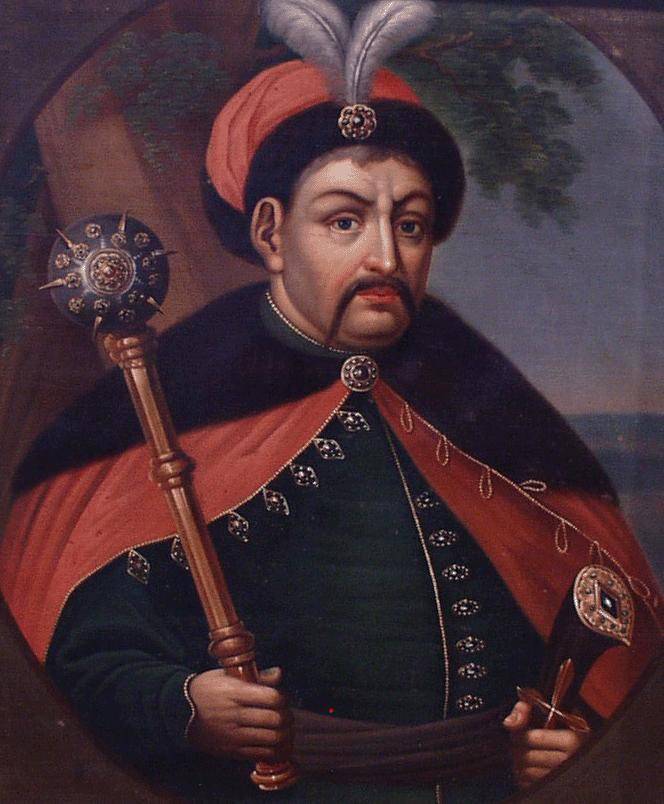
In the 1608 year, after graduating from the Kiev fraternal (Orthodox) school, when Bogdan knocked 12 years old, his father sent him to study at one of the best Jesuit collegia - the brotherly school in Lviv, where all the then “students” studied the traditional set of academic disciplines: Old Slavonic, Greek and Latin languages, grammar, rhetoric, poetics, elements of philosophy, dialectics, as well as arithmetic, geometry, beginnings of astronomy, theology and music. In the 1615 year, after completing the seven-year study that was traditional for that time, Bohdan Khmelnitsky, who among other sciences perfectly mastered French, Polish and German, could go to Warsaw and start a brilliant career here at the court of King Sigismund III himself. However, his father recalled his son in Chigirin, where he began his military service in the Chigirinsky regiment as a regular registered Cossack, serving in the military service of the “Polish Coruna”.
Already in 1620, when the next Turkish-Polish war broke out, young Bogdan along with his father participated in the campaign of the great crown hetman and great chancellor Stanislav Zolkiewski to Moldavia, where his father, together with his long-term benefactor, died in the famous Battle of Tsetsors, and Bogdan himself captured by the enemy.
As many historians believe, two or three years of heavy slavery in the Turkish gallery (and perhaps in the retinue of one of the Turkish admirals) did not pass for Bogdan in vain, because in captivity he managed to learn Turkish, and possibly Tatar. And in 1622 / 1623, he returned to his homeland, being redeemed from Turkish captivity, either by some nameless Dutch merchant, or by Sigismund III himself, or by his countrymen, the Cossacks of the Chigirinsky regiment, who, remembering the martial affairs of his deceased father, helped Bohdan's mother collect the necessary amount for the redemption of his son from the Turkish bondage.
Upon returning to Subotov, Bogdan Khmelnitsky was again enrolled in the royal registry, and from the middle. 1620-s he begins to actively participate in the sea campaigns of the Cossacks in Turkish cities, including in the suburbs of Istanbul (Constantinople), from where the Cossacks returned to 1629 with rich booty and young Turkish women. Although then, after a rather long stay in Zaporizhska Sich, in 1630, he returned to Chyhyryn and soon married the daughter of his friend, Pereyaslavl Colonel Yakim Somko, Anna (Ganna) Somkovna. In 1632, his firstborn was born - the eldest son Timofey, and soon he was elected centurion of the Chigirinsky regiment.
According to the Polish chronicler Vespiyan Kokhovsky, it was in this capacity that Bogdan Khmelnitsky in 1630 took an active part in the famous uprising of the Zaporozhye hetman Taras Tryilo in the famous uprising. However, modern historians, in particular, Gennady Sanin, deny this fact. Moreover, in stories The new uprisings of the Zaporizhzhya Cossacks against the Polish crown, including Ivan Sulyma in 1635, the name of Bogdan Khmelnitsky is no longer found. Although it was reliably established that it was he who in 1637, being already a troop (general) clerk of the Zaporozhye army, signed the capitulation of the lower (not registered) Cossacks who were defeated during the new uprising led by hetman Pavel Pavlyuk.
At the same time, according to the statement of the “Samopov samovid’s Chronicle,” whose authorship is attributed to Roman Rakushka-Romanovsky, when Bogdan Khmelnitsky joined the Polish throne in the Polish throne (1632 – 1648) and the Smolensk war began between Poland and the Russian Federation in the Russian Union of Nations in Russia in the Russian Union of Nations in Russia in the Russian Union of Independent States. –1633's. Moreover, as the Kharkov professor Peter Butsinsky, the author of his master's thesis “About Bogdan Khmelnytsky”, established, in 1634, he received a golden saber from the hands of the Polish king for personal bravery and his salvation from enemy captivity during one of the clashes with the regiments of the governor Mikhail Shein. True, much later, at the height of the next Russian-Polish war of 1635 – 1654, the Zaporozhye hetman allegedly reproached himself for this royal reward, stating to the Moscow ambassadors that “this saber is Bogdan’s shame”.
It is clear that after such a high award, Bogdan Khmelnitsky received a special position of the Polish king and three times - in 1636, 1637 and 1638 - was part of the Cossack deputations to present to the Valnom (general) Seym and Vladislav IV numerous complaints and petitions about violence and ruin, urban registry Cossacks from the Polish magnates and the Catholic gentry. Meanwhile, according to a number of modern authors, including Gennady Sanin, Valery Smolia, Valery Stepankov and Natalia Yakovenko, after the famous 1638 – 1639 ordination, which significantly curtailed the rights and privileges of the registered Cossacks, Bogdan Khmelnitsky lost the position of troop clerk and again became centurion Chigirinsky regiment.
Meanwhile, in 1645, Vladislav IV, who had long fought with the Valnom Diet, decided to provoke a new war with the Ottoman Empire, so that, under the pretext of this military conflict, to substantially replenish the Quartz (Royal Regular) Army, as the Polish magnates by this time fully controlled the collection Commonwealth of destruction (gentry militia). To this end, he decided to rely on a Cossack sergeant and entrusted his plan to three authoritative personalities - Cherkasy colonel Ivan Barabash, Pereyaslavsky colonel Ilyash Karaim (Armenian) and Chigirinsky centurion Bogdan Khmelnitsky. At the same time, the Polish king granted to the registered Cossacks his Universal, or Priviley, to restore their desecrated rights and privileges taken from the Cossacks in 1625 year. Although the matter did not come to the next war with the Turks, since the “royal party” recruited Cossack troops caused terrible agitation among the Polish magnates and gentry, and Vladislav IV was forced to abandon his previous plans to settle accounts with Valnom Diet. Nevertheless, the royal Priviley remained with the Cossacks and, according to various sources, was secretly kept either by Illyash Karaim or Ivan Barabash. When the Polish king suffered another setback in the fight against the magnate opposition, then, according to historians (Nikolai Kostomarov, Gennady Sanin), Bogdan Khmelnitsky lured the royal Priviley with cunning and decided to use this letter for his far-reaching plans.
It must be said that different historians interpret these plans differently, but most of them, for example, Gennady Sanin, Valery Smoliy and Valery Stepankov, argue that initially the plans of Khmelnitsky himself, as well as most of the Cossack elders and the top Orthodox clergy, included the creation of an independent Cossack state independent of Turkey, the Commonwealth and Russia.
Meanwhile, a number of modern authors, in particular, Gennady Sanin, believe that frequent visits to Warsaw as part of Cossack delegations allowed Khmelnytsky to establish fairly trusting relations with the French envoy to the Polish court, Count de Brezi, who soon signed a secret agreement to send 2500 Cossacks to France, which, within the framework of the famous Thirty Years War (1618 – 1648), took an active part in the siege of Dunkirk by the French Prince Louis Conde. And, interestingly, according to Polish and French chronicles (for example, Pierre Chevalier) and according to many Ukrainian and Russian historians, Bogdan Khmelnitsky not only received a personal audience with Prince Condé during his stay in Fontainebleau, but also a personal message from the English leader revolutionaries "Lieutenant-General of the parliamentary army of Oliver Cromwell, who then led the armed struggle against the English King Charles I. Although it should be recognized that this rather walking version was refuted in the works of the famous Soviet Institute Ain historian Vladimir Golobutskogo and contemporary Polish historian Zbigniew Wójcik, who authoritatively stated: in fact, in the siege and capture of Dunkirk took part the Polish squad of mercenaries, commanded by Colonel Krzysztof Pshiemsky.
Meanwhile, in the spring of 1647, taking advantage of the absence of Bogdan in Chigirin, the Chigirin underworld Daniel Chaplinsky, who had an old personal dislike with his neighbor, attacked his village, looted him, took away his new “civilian” wife named Gelena, with whom he began to live after the death of his first wife, he married her according to the Catholic rite and carved him to the death of his youngest son Ostap, who was barely ten years old.
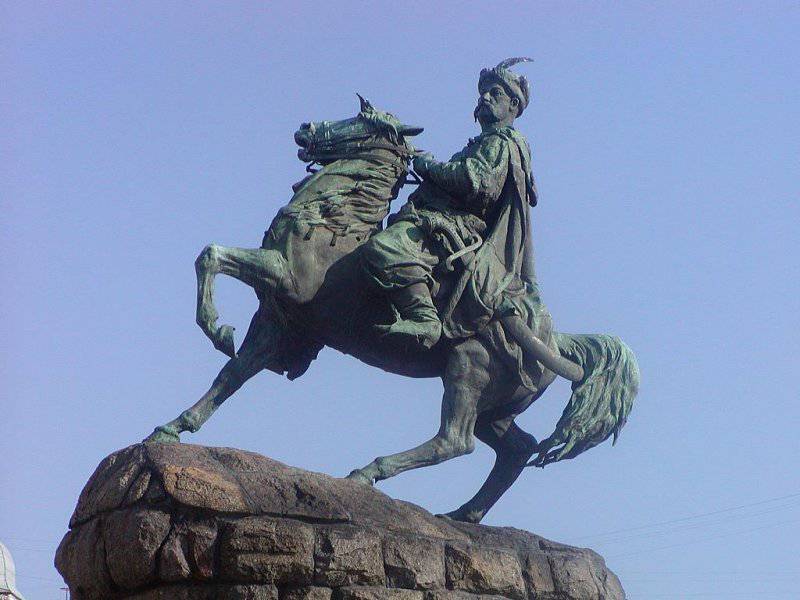
Initially, Khmelnitsky began to seek the truth and protection in the crown court, however, not finding them, he appealed to the king, who told him that the Cossacks, having a “sable in a belt,” had the right to defend their legal rights with weapons in hand. Returning from Warsaw, he decided to resort to the “wise” advice of the king and, relying on his Privileges, began to prepare a new uprising of the Zaporozhye Cossacks. True, soon a certain Roman Pest reported on the intentions of Bohdan Khmelnytsky to the Chigirin headman, Alexander Konetspolsky, who ordered his arrest. But with the support of his faithful comrade, Chigirinsky Colonel Mikhail Krichevsky, who himself was involved in the preparation of a new Cossack riot, Khmelnitsky escaped imprisonment and in early February 1648, led by a Cossack detachment, arrived on Tomakovka island.
Having gathered around him local Cossacks, he moved to Khortytsya, in the Zaporizhian Sich itself, located on the Nikitsky Horn. Here, the Khmelnitsky detachment defeated the Polish garrison and forced Cherkasy Colonel Stanislav Jurassky to flee, whose Cossacks immediately joined the insurgent detachment of the registered and Zaporozhye Cossacks, saying that “fight Cossacks against Cossacks — all is one thing, orami”.
In early April, 1648, having entered into secret negotiations with the Crimean Khan Islam III Giray, Khmelnitsky got him to send a large detachment of the Perekop Murza Tugay-Bey to help the Cossacks. This unexpected "foreign policy" success played into the hands of Khmelnitsky, who, upon returning to the Sich, was immediately elected troop hetman of the Zaporozhye army.
At the end of April 1648, the 12-thousandth Crimean-Cossack army, bypassing the Kodak fortress, withdrew from the Sich and went to meet the quartz detachment of Stefan Potocki, who spoke from Krylov to meet the Cossacks. Moreover, both the hetman of the field - the crown Nikolai Pototsky and the field Martin Kalinovsky - remained in their camp located between Cherkasy and Korsun, waiting for reinforcements.
Meanwhile, Bogdan Khmelnitsky went to the mouth of the river Tiasmin and camped on its tributary - Yellow Waters. It was here that the 5-thousandth detachment under the command of Stefan Potocki was completely defeated, and his young leader, the son of Nikolai Pototsky, was fatally injured and died. Then the Crimean Cossack army moved to Korsun, where in the middle. May 1648, a new battle took place on Boguslavsky Shlyakha, which resulted in the death of almost the entire 20-thousandth Quartz Army and the capture of Nikolay Pototsky and Martin Kalinovsky, who were presented with the gift of Tugay-Bey as a gift.
The defeat at the Yellow Waters surprisingly coincided with the sudden death of Vladislav IV, which caused a murmur among the Polish gentry and magnates. And, interestingly, according to a number of current historians, in particular, Gennady Sanin, already in June 1648, Khmelnitsky sent a personal message to Tsar Alexei Mikhailovich to Moscow with an unusual proposal to run for the election of the new Polish king. And, although it, of course, remained unanswered, the fact of the establishment of direct contacts of the hetman with Moscow is important.
By the end of the summer, 40-thousandth Polish commonwealth was assembled in Volyn as part of the Polish gentry and zholner, which, due to the captivity of both hetmans, were headed by three coronial commissars - Vladislav Zaslavsky, Alexander Konetspolsky and Nikolai Ostorog, whom Bohdan Khmelnitsky himself jokingly called “Perina, Dimitinos’ Latin. All R. On September 1648, both armies met at the village of Pilyavtsy near Starokonstantinov, where on the banks of the Ykva River, the Crimean-Cossack army won a brilliant victory and plunged the enemy into a stampede, who left guns on the 90 battlefield, tons of gunpowder and huge trophies, which cost no. 7 million gold.
After such a brilliant victory, the rebel army rushed to Lvov, which hastily abandoned by field hetman Jeremiah Vishnevetsky, were themselves defended by the townspeople headed by the local mayor Martin Groswier. However, after taking part of the Lviv fortifications by the detachment of Maxim Kryvonos, the Lvov citizens paid a small contribution to the Cossacks for lifting the siege of the city, and in late October Bogdan Khmelnitsky headed towards Zamosty.
Meanwhile in the middle. November 1648 was the younger Polish brother of the late Vladislav IV Jan II Casimir (1648 – 1668), who ascended the throne, including with the support of Bohdan Khmelnitsky himself and the Cossack petty deputation, who apparently agreed with him that he would support registered Cossacks in the fight against the Polish and Lithuanian gentry and tycoons for their equal rights with them.
At the very beginning. January 1649, Bogdan Khmelnitsky triumphantly entered Kiev, where a new round of negotiations with the Polish side, begun back in Zamoć, soon began. Moreover, according to the information of the modern authors, Natalya Yakovenko and Gennady Sanin, who refer to the testimonies of the head of the Polish delegation, the Kiev governor Adam Kissel, before their start, Bogdan Khmelnitsky told the entire Cossack foreman and the Polish delegation that now he is a small man who has become according to the will of God, the “one owner and autocrat, Ruthenian”, will knock out “all the Ruthenian people out of Lyadskaya bondage” and from now on will “fight for our Orthodox faith, because the land of Lyadskaya is sinister, and Russia will be panuvati”.
Already in March, 1649, Bogdan Khmelnitsky, who had long sought reliable allies in the fight against the Polish crown, sent a policeman, Colonel Siluyan Muzylovsky to Moscow with a personal message to Tsar Alexei Mikhailovich, in which he asked him to take the “Zaporozhskoye army under the high sovereign’s hand” and give him a favor help in the fight against Poland. This message was favorably received in Moscow, and under the tsar's order in Chigirin, where the headquarters and the office of the Zaporozhye hetman were then located, the first Russian ambassador, the head clerk Gregory Unkovsky, left, who signed the following agreement with Bogdan Khmelnitsky: 1) since Moscow is currently forced to comply with the terms of the Polyanovo Peace Treaty (1634), then it will not be able to start a new war with Poland, but will provide all possible assistance to the Zaporozhye hetman with finances and weapons; 2) Moscow will not object if, at the request of the Zaporozhian Cossacks, the Don Cossacks take part in hostilities against the Polish crown.
Meanwhile, Jan II Casimir unexpectedly resumed hostilities against Bogdan Khmelnitsky, although already in August 1649, the crown army under the leadership of the king himself was completely defeated under Zborov, and he was forced to announce the “Grace of His Royal Majesty the Zaporozhian Army to the points proposed in their petition ". The essence of these privileges was as follows: 1) Warsaw officially recognized Bogdan Khmelnytsky as a hetman of the Zaporozhsky army and transferred to it Kiev, Bratslav and Chernihiv voivodship; 2) the quartering of the Polish crown troops was forbidden on the territory of these voivodships, but the local Polish gentry received the right to return to their possession; 3) the number of the registered Cossacks in the service of the Polish crown increased from 20 to 40 thousand sabers.
Naturally, Bogdan Khmelnitsky attempted to make the most of the new truce to find new allies in the fight against the Polish crown. Enlisting the support of Moscow, where the idea of an alliance with the Zaporozhye hetman supported the Zemsky Sobor in February 1651 of the year, and Bakhchisarai, who entered into a military alliance with the Cossacks, Bogdan Khmelnitsky resumed hostilities against Poland. But in June, 1651 under Berestechko because of the mean betrayal of the Crimean Khan Islam III Giray, who fled from the battlefield and forcibly detained Bogdan Khmelnitsky in his camp, the Zaporozhye Cossacks suffered a crushing defeat and were forced to sit at the negotiating table. In September, 1651, the belligerents signed the Belotserkovsky peace treaty, under the terms of which: 1) the Zaporozhye hetman lost the right of external relations; 2) only Kiev Province remained in its management; 3) the number of registered Cossacks was again reduced to 20 thousand sabers.
At this time, Bogdan Khmelnitsky himself had to go through a difficult personal drama. His second wife Gelena (in Orthodoxy Motron), with whom he married in 1649, suspected of adultery with a trooper, was ordered by Timofei Khmelnitsky, who did not like her stepmother, was hanged with her thieving lover.
Meanwhile, the new world with Rzecz Pospolita turned out to be even less durable than the previous one, and soon the fighting resumed, which even the Russian Ambassador Boyar Boris Repnin-Obolensky, who promised to forget the violation of the conditions of the old Polyanovo Treaty by Poles, could not prevent Belotserkovsky from Warsaw contract
In May, 1652 of the year, Bogdan Khmelnitsky defeated under Batog the army of crown field hetman Martin Kalinovsky, who fell in this battle with his son, the clerk of baggage Samuel Ezhi. And in October 1653, he defeated the 8-thousandth detachment of Colonels Stefan Charnetsky and Sebastian Makhovsky in the battle of Zhvants. As a result, Jan II Casimir was forced to enter into new negotiations and sign the Zhvanetsky peace treaty, which exactly reproduced all the conditions of the “Zboriv grace” granted to the Cossacks in 1649 year.
Meanwhile, in October 1653, a new Zemsky Sobor was held in Moscow, which, in a new, fifth way, asked the hetman ambassadors of Kondrat Burylaya, Siluyan Muzhilovsky, Ivan Vyhovsky and Grigory Gulyanitsky, finally made a firm decision to take the Zaporozhye army under the “high hand” of the Russian Tsar and the beginning of the war with Poland. In order to formalize this decision, the Grand Embassy was composed of Bogdan Khmelnitsky at the headquarters of Boyar Vasily Buturlin, Okolichykh Ivan Alferov and Artamon Matveyev and Duma Diary Hilarion Lopukhin. In January, 1654 was held in Pereyaslavl by the Combined Arms Council, during which the Zaporozhye hetman, the entire military foreman and representatives of the 166 "Cherkasy" cities gave the oath to be "eternal subjects to his royal majesty All-Russian and his heirs."
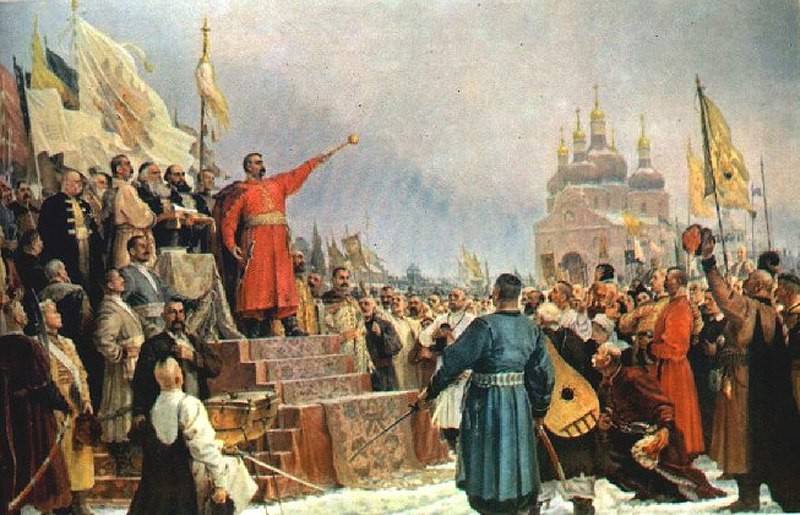
In March, 1654 in Moscow in the presence of Tsar Alexei Mikhailovich, members of the Boyar Duma, the Consecrated Cathedral and the Hetman Ambassadors - military judge Samuil Bogdanovich and Pereyaslav Colonel Pavel Teteri - signed a historic treaty on the reunification of the original Russian lands with Russia. In accordance with the "March Articles": 1), the entire administrative, that is, the military-regimental control system remained in the whole territory of Little Russia, "that the Hetman be elected to the Zaporozhian Samozhey itself and the Royal Majesty be informed that because that long-standing military custom "; 2) “In the Zaporozhian Troops, that they narrowed their rights and had their liberties in the courts and in the courts, so that neither the voivode, nor the boyar, nor the stolnik could join the courts in the courts”; 3) “Zaporozhian army in the number of 60 000 so that it was always full”, etc. And, what is particularly interesting, the “March Articles” detailed the specific size of the sovereign's salary and land holdings of the entire Cossack (military and junior) foremen, in particular, the military clerk, military judges, military colonels, regimental esaulov and centurions.
It must be said that in modern Ukrainian historiography, and in the wide public consciousness of many “Ukrainians,” there persists a steady myth about the existence of a special form of republican rule in Little Russia (Hetmanate), which visibly manifested itself in the form of a free Cossack state. However, even a number of modern Ukrainian historians, in particular, Valery Smoliy, Valery Stepankov and Natalya Yakovenko, rightly say that in the so-called Cossack Republic much visible elements of terry authoritarianism and oligarchic rule were present, especially during the hetmanship of Bohdan Khmelnytsky , Ivan Vyhovsky, Yuri Khmelnitsky and Paul Teteri. Moreover, almost all applicants for the hetman's mace, outwardly demonstrating their commitment to the ideas of subordinating hetman powers to the “collective will” of the Zaporozhian army, in fact, made every effort to expand the boundaries of their authoritarianism and even pass the hetman's mace. Moreover, Professor Natalya Yakovenko directly stated that it was under Bohdan Khmelnytsky that the regime of military dictatorship was established in the Hetmanate, since all the leading posts here were occupied exclusively by military officers. It is also well known that many Little Russian hetmans, after coming to power, pursued a policy of terror against all political opponents. For example, the same Ivan Vyhovsky only in June 1658, executed Pereyaslavsky Colonel Ivan Sulimu, Korsun Colonel Timothy Onikienko and more than a dozen regimental head officers. Therefore, fleeing the hetman's terror, the Uluansky colonel Ivan Bespalyi, the Pavolotsky colonel Mikhail Sulichich, the general esaul Ivan Kovalevsky, the punitive hetman Yakim Somko and many others fled from the Ukraine.
Also unreasonable are the constant references and the unfounded moaning of Ukrainian independenceists about the special national autonomous status of Left-Bank Ukraine (Little Russia) as part of the Moscow kingdom, since in reality it was not national or regional, but military-class autonomy, stemming from the special border position of Little Russia and New Russia lands located on the borders with the Crimean Khanate and the Commonwealth. Exactly the same military estate autonomy existed in the lands of the Don and Yaik Cossack troops, which, like the Zaporozhye Cossacks, carried out frontier service on the southern frontiers of the Moscow kingdom, and then the Russian Empire.
Taking the Zaporozhye army and the entire Hetman under his “high hand”, Tsar Alexei Mikhailovich, of course, took into account the inevitability of war with Poland, so this decision was made only when the Russian army was able to start a new war with its old and strong adversary. The new Russian-Polish war began in May 1654, when the 100-thousandth Russian army marched in three main directions: Tsar Alexei Mikhailovich himself led the main forces from Moscow to Smolensk, Prince Alexei Trubetskoy with his regiments made a connection from Bryansk with the troops of Hetman Bohdan Khmelnytsky, and the boyar Vasily Sheremetev from Putivl went out with the Zaporozhian Cossacks. In order to prevent the possible performance of the Turks and the Crimean Tatars, at the same time a boyar Vasily Troyekurov was sent to the Don to instruct the Don Cossacks to keep a watchful eye on the Crimean frontiers and, if necessary, not to oppose the enemy.
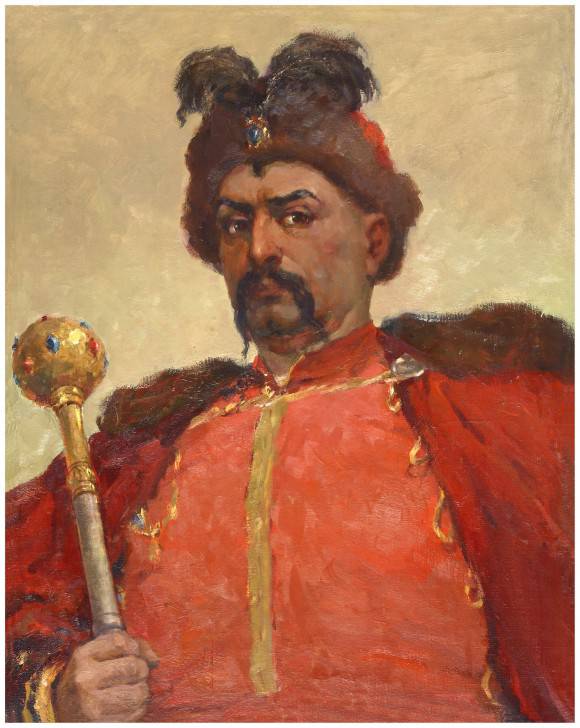
During the 1654 military campaign of the year, the Russian army and the Zaporozhye Cossacks, inflicting a series of major defeats on the Polish-Lithuanian Kvatsyarny army of the hetmans Stefan Potocki and Janusz Radziwill, took Smolensk, Dorogobuzh, Roslavl, Polotsk, Gomel, Orsha, Shklov, and Yman and other people and other people. Little Russia. The 1655 military campaign of the year also proved to be extremely successful for the Russian army, which inflicted a number of major defeats on the Poles and captured Minsk, Grodno, Vilna, Kovno, and advanced to Brest. But by the summer of 1655, the situation on the territory of Little Russia itself was seriously complicated, because part of the Cossack officers, who did not recognize the decisions of Pereyaslavl Council, supported the Polish gentry, and the crown hetman Stefan Pototsky managed to assemble and arm the new army. However, in the middle. On June 1655, selected regiments of Bogdan Khmelnitsky, Aleksei Trubetskoy and Vasily Buturlin defeated the Poles near Lvov, and the city itself was taken to the ring. In the meantime, the new Crimean Khan Mehmed IV Giray decided to help Warsaw and invaded the borders of Polish Ukraine, but in the Ozernaya region the Tatars were defeated and hastily retreated back home. After these events, the Polish king Jan II Casimir fled to Silesia in panic, and the Lithuanian hetman Janusz Radziwill went over to the Swedish king Charles X Gustav, who a year ago started the Northern War (1655 – 1660) with the Polish crown.
The crushing military defeat of Poland was skillfully used in Stockholm, and at the end of 1655, the Swedish army captured Poznan, Krakow, Warsaw and other cities of the southern neighbor. This situation radically changed the course of further events. Not wanting to strengthen the position of Sweden in the strategically important Baltic region, under pressure from the head of the Ambassadorial Order Afanasy Ordin-Nashchokin Alexei Mikhailovich declared war on Stockholm, and in May 1656, the Russian army hastily moved to the Baltic States. Although, according to historians (Gennady Sanin), Patriarch Nikon, Vasily Buturlin, and Grigory Romodanovsky, and other members of the Boyar Duma opposed this war.
The beginning of the new Swedish campaign was very successful for the Russian army, and literally in one month it took possession of Dinaburg and Marienburg and began the siege of Riga. However, in the beginning. October, having received the news that Karl X was preparing a campaign in Livonia, the siege of Riga had to be lifted and retreated to Polotsk. In this situation, in October 1656, Moscow and Warsaw signed the Vilna truce and began joint combat operations against the Swedish army, which at that time took control of a large part of Polish territory.
This circumstance very frightened Bogdan Khmelnitsky, and in February 1657, he entered into a military alliance with the Swedish king Charles X, sending thousands of Zaporozhye Cossacks to help his new allies 12. Upon learning of this, the Poles immediately notified Moscow of this fact, from where an ambassadorial mission was headed to Bogdan Khmelnitsky, led by the boyar Bogdan Khitrovo, who found the Zaporozhye hetman already seriously ill. Trying to justify himself before the royal ambassador, he told that in February 1657, the royal envoy Colonel Stanislav Benevsky came to Chigirin, who offered him to go to the king's side, therefore "because of such tricks and lies, we opposed part of the Zaporozhian Army". Due to these clearly contrived reasons, Bogdan Khmelnitsky himself refused to withdraw his Cossacks from the Polish front, however, the Zaporozhians themselves, having learned that their campaign was not coordinated with Moscow, returned by their own means and said to their foreman: those times you leaned towards the sovereign, but as you see, behind the sovereign's defense, you saw room and much possession and enriched yourself, so you really want to be a self-styled panami ”.
It must be admitted that this version of events is contained in the works of many, including the current Ukrainian historians. Although it should be said that the modern Russian historian Gennady Sanin, on the contrary, asserts that Moscow was fully aware of the behavior of Bohdan Khmelnytsky and even sent to Chigirin the ambassadorial deacon Artamon Matveyev, who presented him with “many sables” on behalf of the king.
Shortly after the departure of Bogdan Khitrovo, Bogdan Khmelnitsky, feeling the imminent death, ordered to convene the Combined Arms Council in Chigirin to choose his successor, and the military foreman elected his younger 16-year-old son Yuri Khmelnitsky to be the new Zaporozhian hetman. However, after the death of his father, in October 1657, the head of the military office, Ivan Vyhovsky, was elected on the new Combined Arms Rada, convened already in Korsun, as a new Zaporozhian hetman.
It must be said that for quite a long time the date of Khmelnitsky’s death caused heated debates. However, it is now precisely established that he died 27 on July 1657 of the year from a hemorrhagic stroke in Chigirin and was buried next to the body of the deceased older son Timofei in the family farm Subotov, in the stone Illyinsky church he had built. True, in 1664, the Polish voivode Stefan Charnetsky burned Subotov, ordered the ashes of Khmelnytsky and his son Timothy to be dug up and to throw their bodies away for "devouring to dogs" ...
- Yevgeny SPITSYN
- http://xn--h1aagokeh.xn--p1ai/special_posts/%D0%B4%D1%83%D0%BC%D0%B0-%D0%BE-%D0%B3%D0%B5%D1%82%D0%BC%D0%B0%D0%BD%D0%B5-%D0%B1%D0%BE%D0%B3%D0%B4%D0%B0%D0%BD%D0%B5/
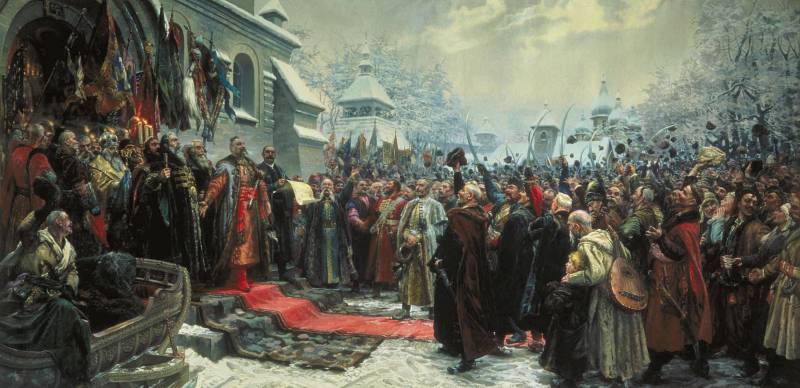
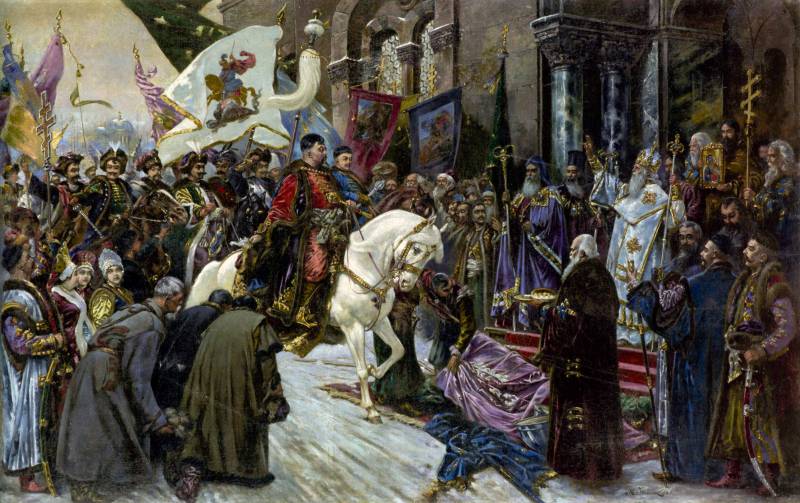
Information